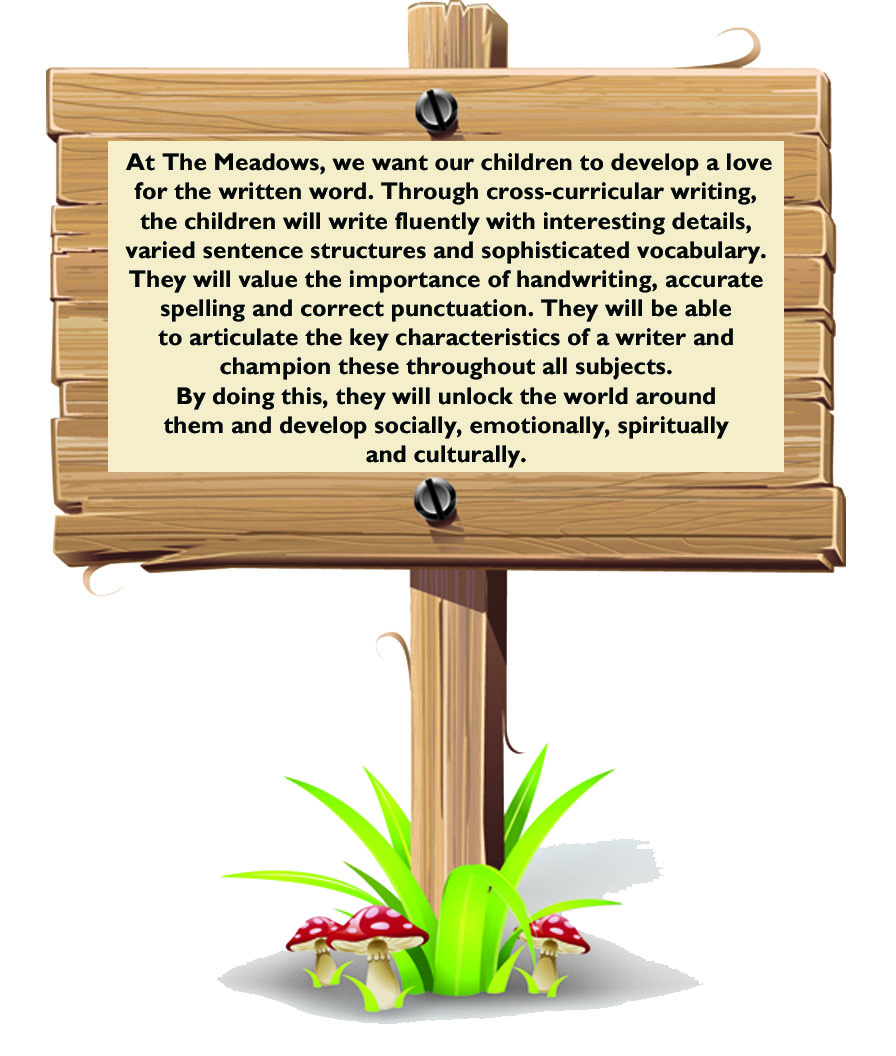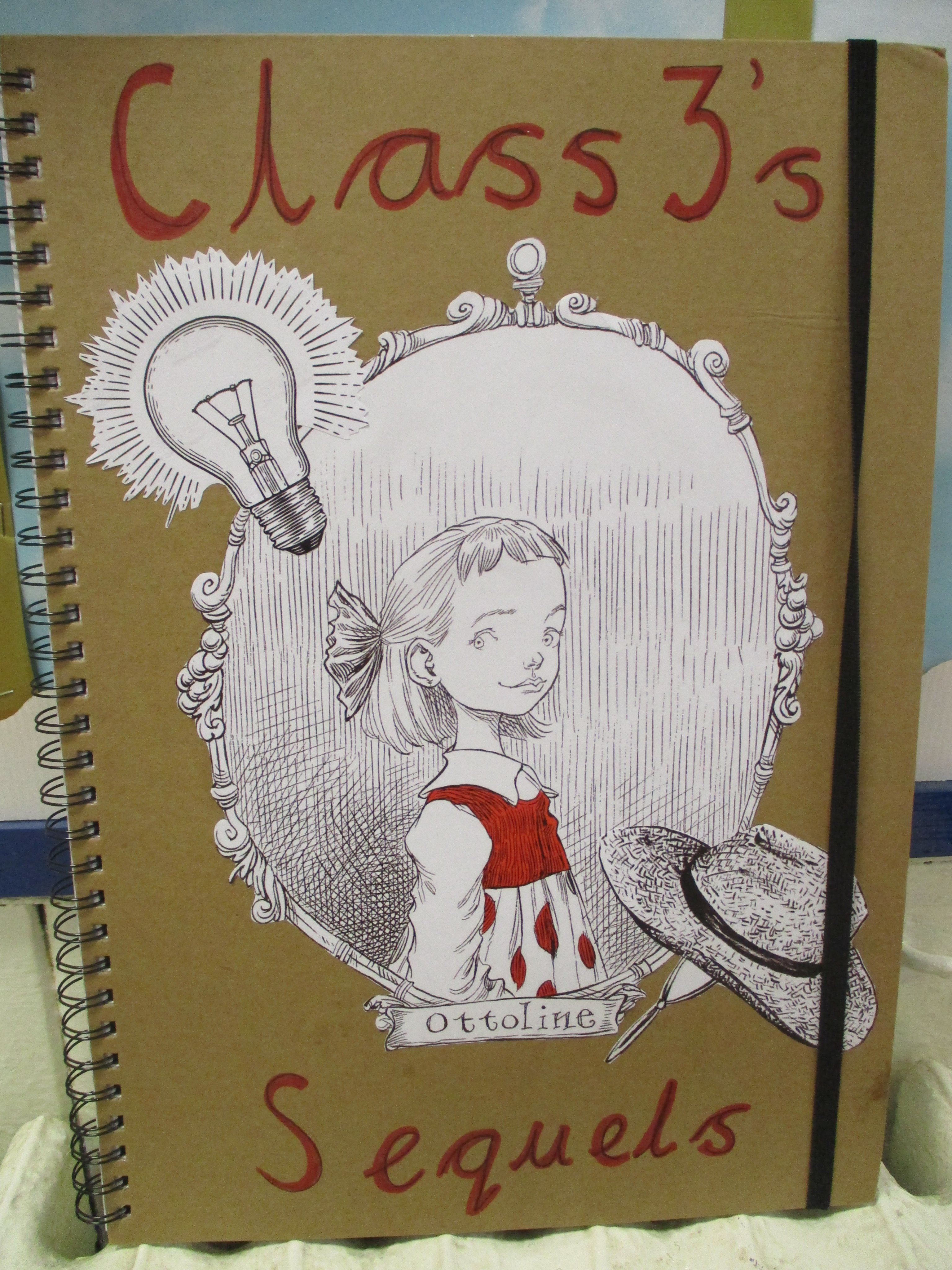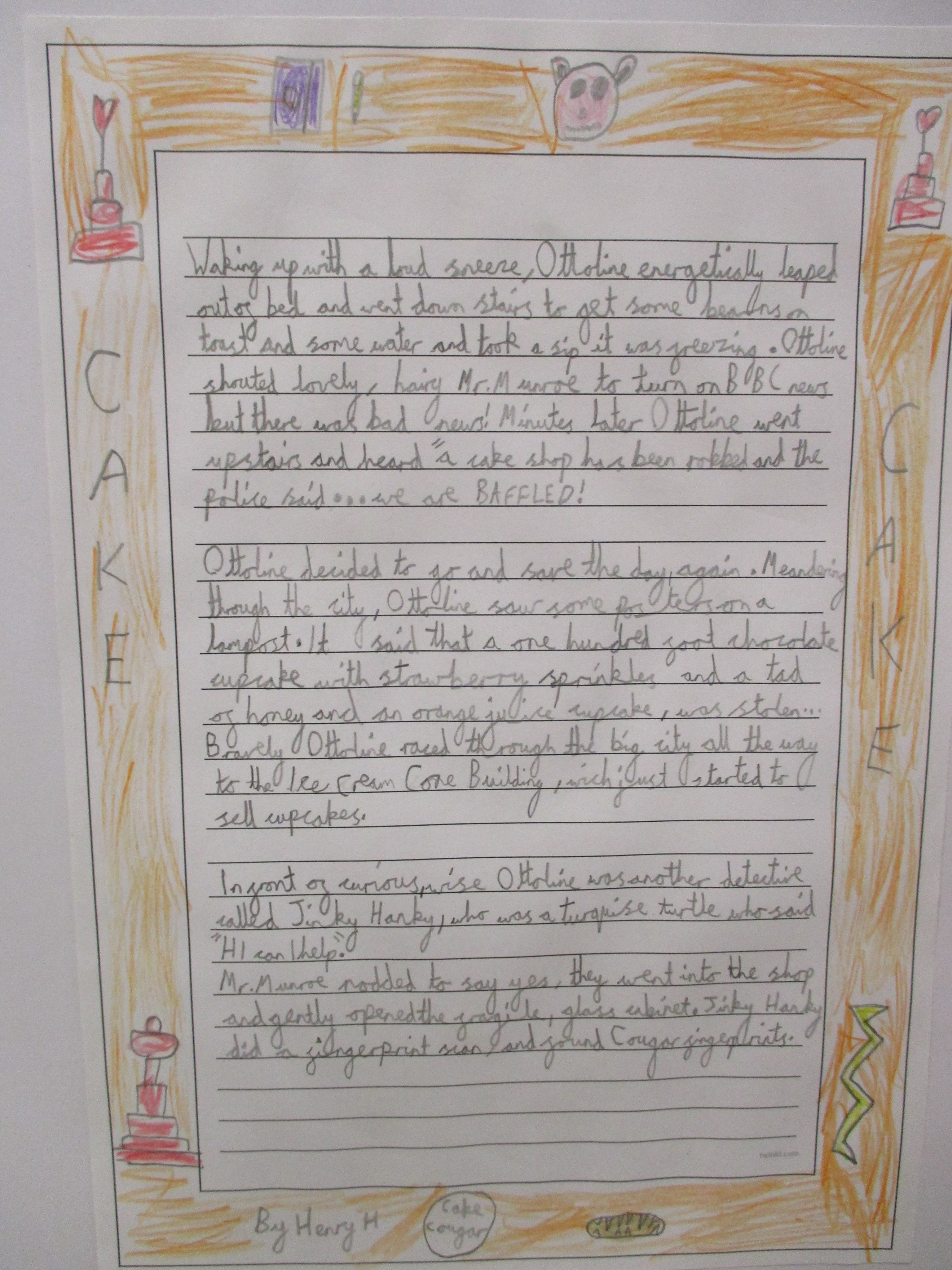Curriculum Intent: English - Writing

Our Curriculum Drivers

Characteristics of a Writer
- The ability to write fluently and with interesting detail on a number of topics throughout the curriculum.
- A vivid imagination which makes readers engage with and enjoy their writing.
- A highly developed vocabulary and an excellent knowledge of writing techniques to extend details or description.
- Well-organised and structured writing, which includes a variety of sentence structures.
- Excellent transcription skills that ensure their writing is well presented and punctuated, spelled correctly and neat.
- A love of writing and an appreciation of its educational, cultural and entertainment values.
Implementation
Our pupils should be able to organise their knowledge, skills and understanding around the following learning hooks:
- To present neatly
- To spell correctly
- To punctuate accurately
- To use sentences appropriately
- To write with purpose
- To use imaginative description
- To organise writing appropriately
- To use paragraphs
- To analyse writing
- To present writing
These key concepts or as we like to explain them to children – learning hooks, underpin learning in each milestone. This enables pupils to reinforce and build upon prior learning, make connections and develop subject specific language.
A copy of our writing progression within the Write Stuff can be found here. Additional information regarding EYFS progression can be found here.
The vertical accumulation of knowledge and skills from Years 1 to 6 is mapped as follows:
|
Threshold Concept Key Skills |
Milestone 1 Years 1 and 2 |
Milestone 2 Years 3 and 4 |
Milestone 3 Years 5 and 6 |
|
To write with purpose |
• Say first and then write to tell others about ideas.
• Write for a variety of purposes.
• Plan by talking about ideas and writing notes.
• Use some of the characteristic features of the type of writing used.
• Write, review and improve. |
• Use the main features of a type of writing (identified in reading).
• Use techniques used by authors to create characters and settings.
• Compose and rehearse sentences orally.
• Plan, write, edit and improve. |
• Identify the audience for writing. • Choose the appropriate form of writing using the main features identified in reading. • Note, develop and research ideas. • Plan, draft, write, edit and improve.
|
|
To use imaginative description |
• Use well-chosen adjectives to add detail. • Use names of people, places and things. • Use well-chosen adjectives. • Use nouns and pronouns for variety. • Use adverbs for extra detail.
|
• Create characters, settings and plots. • Use alliteration effectively. • Use similes effectively. • Use a range of descriptive phrases including some collective nouns.
|
• Use the techniques that authors use to create characters, settings and plots. • Create vivid images by using alliteration, similes, metaphors and personification. • Interweave descriptions of characters, settings and atmosphere with dialogue.
|
|
To organise writing appropriately |
• Re-read writing to check it makes sense. • Use the correct tenses. • Organise writing in line with its purpose.
|
• Use organisational devices such as headings and sub headings. • Use the perfect form of verbs to mark relationships of time and cause. • Use connectives that signal time, shift attention, inject suspense and shift the setting.
|
• Guide the reader by using a range of organisational devices, including a range of connectives. • Choose effective grammar and punctuation. • Ensure correct use of tenses throughout a piece of writing.
|
|
To use paragraphs |
• Write about more than one idea. • Group related information.
|
• Organise paragraphs around a theme. • Sequence paragraphs.
|
• Write paragraphs that give the reader a sense of clarity. • Write paragraphs that make sense if read alone. • Write cohesively at length.
|
|
To use sentences appropriately |
• Write so that other people can understand the meaning of sentences. • Sequence sentences to form clear narratives. • Convey ideas sentence by sentence. • Join sentences with conjunctions and connectives. • Vary the way sentences begin.
|
• Use a mixture of simple, compound and complex sentences. • Write sentences that include: • conjunctions • adverbs • direct speech, punctuated correctly • clauses • adverbial phrases.
|
• Write sentences that include: • relative clauses • modal verbs • relative pronouns • brackets • parenthesis • a mixture of active and passive voice • a clear subject and object • hyphens, colons and semi colons • bullet points.
|
|
To present neatly |
• Sit correctly and hold a pencil correctly. • Begin to form lower-case letters correctly. • Form capital letters. • Form digits 0-9. • Understand letters that are formed in similar ways. • Form lower-case letters of a consistent size. • Begin to join some letters. • Write capital letters and digits of consistent size. • Use spacing between words that reflects the size of the letters.
|
• Join letters, deciding which letters are best left un-joined. • Make handwriting legible by ensuring downstrokes of letters are parallel and letters are spaced appropriately.
|
• Write fluently and legibly with a personal style.
|
|
To spell correctly |
• Spell words containing 40+ learned phonemes. • Spell common exception words (the, said, one, two and the days of the week). • Name letters of the alphabet in order. • Use letter names to describe spellings of words. • Add prefixes and suffixes, learning the rule for adding s and es as a plural marker for nouns, and the third person singular marker for verbs (I drink - he drinks). • Use the prefix un. • Use suffixes where no change to the spelling of the root word is needed: helping, helped, helper, eating, quicker, quickest. • Use spelling rules. • Write simple sentences dictated by the teacher. • Spell by segmenting words into phonemes and represent them with the correct graphemes. • Learn some new ways to represent phonemes. • Spell common exception words correctly. • Spell contraction words correctly (can’t, don’t). • Add suffixes to spell longer words (-ment, -ness, -ful and -less). • Use the possessive apostrophe. (singular) (for example, the girl's book) • Distinguish between homophones and near-homophones.
|
• Use prefixes and suffixes and understand how to add them. • Spell homophones correctly. • Spell correctly often misspelt words. • Place the possessive apostrophe accurately in words with regular plurals (for example, girls’, boys’) and in words with irregular plurals (for example, children’s). • Use the first two or three letters of a word to check its spelling in a dictionary. • Write from memory simple sentences, dictated by the teacher, that include words and punctuation taught so far.
|
• Use prefixes appropriately. • Spell some words with silent letters (knight, psalm and solemn). • Distinguish between homophones and other words that are often confused. • Use knowledge of morphology and etymology in spelling and understand that some words need to be learned specifically. • Use dictionaries to check spelling and meaning of words. • Use the first three or four letters of a word to look up the meaning or spelling of words in a dictionary. • Use a thesaurus. • Spell the vast majority of words correctly.
|
|
To punctuate accurately |
• Leave spaces between words. • Use the word ‘and’ to join words and sentences. • Begin to punctuate using a capital letter for the name of people, places, the days of the week and I. • Use both familiar and new punctuation correctly, including full stops, capital letters, exclamation marks, question marks, commas for lists and apostrophes for contracted forms. • Use sentences with different forms: statement, question, exclamation and command. • Use extended noun phrases to describe and specify (e.g. the blue butterfly). • Use subordination (when, if, that or because). • Use coordination (or, and, but). • Use some features of standard written English. • Use the present and past tenses correctly, including the progressive form.
|
• Develop understanding of writing concepts by: • Extending the range of sentences with more than one clause by using a wider range of conjunctions, including when, if, because, although. • Using the present perfect form of verbs in contrast to the past tense. • Choosing nouns or pronouns appropriately for clarity and cohesion and to avoid repetition. • Using conjunctions, adverbs and prepositions to express time and cause. • Using fronted adverbials. • Indicate grammatical and other features by: • Using commas after fronted adverbials. • Indicating possession by using the possessive apostrophe with plural nouns. • Using and punctuating direct speech.
|
• Develop understanding of writing concepts by: • Recognising vocabulary and structures that are appropriate for formal speech and writing, including subjunctive forms. • Using passive verbs to affect the presentation of information in a sentence. • Using the perfect form of verbs to mark relationships of time and cause. • Using expanded noun phrases to convey complicated information concisely. • Using modal verbs or adverbs to indicate degrees of possibility. • Using relative clauses beginning with who, which, where, when, whose, that or with an implied (i.e. omitted) relative pronoun. • Indicate grammatical and other features by: • Using commas to clarify meaning or avoid ambiguity in writing. • Using hyphens to avoid ambiguity. • Using brackets, dashes or commas to indicate parenthesis. • Using semi-colons, colons or dashes to mark boundaries between independent clauses. • Using a colon to introduce a list. • Punctuating bullet points consistently.
|
|
To analyse writing |
• Discuss writing with the teacher and other pupils. • Use and understand grammatical terminology in discussing writing: Year 1 • word, sentence, letter, capital letter, full stop, punctuation, singular, plural, question mark, exclamation mark. Year 2 • Use and understand grammatical terminology in discussing writing: • verb, tense (past, present), adjective, noun, suffix, apostrophe, comma.
|
• Use and understand grammatical terminology when discussing writing and reading: Year 3 • word family, conjunction, adverb, preposition, direct speech, inverted commas (or ‘speech marks’), prefix, consonant, vowel, clause, subordinate clause. Year 4 • pronoun, possessive pronoun, adverbial. |
• Use and understand grammatical terminology when discussing writing and reading: Year 5 • relative clause, modal verb, relative pronoun, parenthesis, bracket, dash, determiner, cohesion, ambiguity. Year 6 • active and passive voice, subject and object, hyphen, synonym, colon, semi-colon, bullet points. |
|
To present writing |
• Read aloud writing clearly enough to be heard by peers and the teacher. • Read aloud writing with some intonation.
|
• Read aloud writing to a group or whole class, using appropriate intonation. |
• Perform compositions, using appropriate intonation and volume. |
Aspirations For The Future
Pupils develop an understanding of how subjects and specific skills are linked to future jobs.
Here are some of the jobs you could aspire to do in the future as a Reader and Writer:
- Publicity Assistant
- Stage Director
- Song Writer
- Entertainment Manager
- Social Media Consultant
- Cartoonist
For more careers, please visit First Careers.
Impact
Assessment
Through the explicit teaching of the Writing skills, both the teachers and the pupils assess their learning continuously throughout the lesson. Our assessment systems enable teachers to make informed judgements about the depth of their learning and the progress they have made over time.
Pupil Voice
"Each week we have a Big Write. This is time for us to apply what we have learnt through the week," - Ellenor
"I love Big Write. I try to write a full page," Alyssa
Snapshots
Here is what Writing looks like at The Meadows:


Disclaimer: This has been developed with reflection upon the National Curriculum (2014) and Chris Quigley’s Essential Curriculum.


